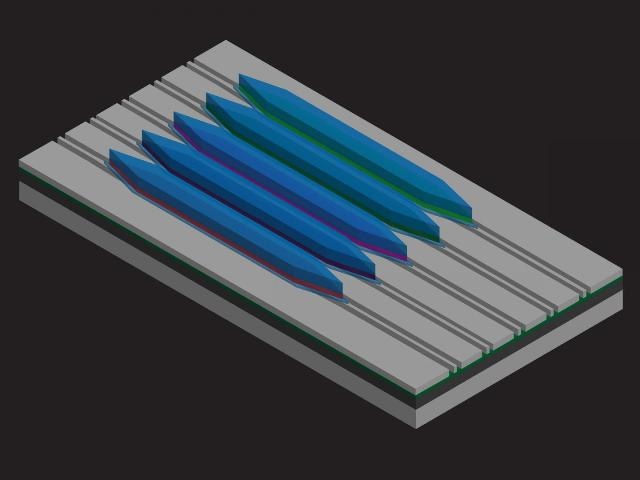Apr 21 2016
A team of researchers from across the country, led by Alexander Spott, University of California, Santa Barbara, USA, have built the first quantum cascade laser on silicon. The advance may have applications that span from chemical bond spectroscopy and gas sensing, to astronomy and free-space communications.
 3-D artistic depiction of multiple Quantum Cascade Lasers integrated above silicon waveguides. (Credit: Alexander Spott)
3-D artistic depiction of multiple Quantum Cascade Lasers integrated above silicon waveguides. (Credit: Alexander Spott)
Integrating lasers directly on silicon chips is challenging, but it is much more efficient and compact than coupling external laser light to the chips. The indirect bandgap of silicon makes it difficult to build a laser out of silicon, but diode lasers can be built with III-V materials such as InP or GaAs. By directly bonding an III-V layer on top of the silicon wafer and then using the III-V layers to generate gain for the laser, this same group has integrated a multiple quantum well laser on silicon that operates at 2 µm. Limitations in diode lasers prevent going to longer wavelengths where there are many more applications, so the group turned their attention to using quantum cascade lasers instead.
Building a quantum cascade laser on silicon was a challenging task made more difficult by the fact that silicon dioxide becomes heavily absorptive at longer wavelengths in the mid-infrared. “This meant that not only did we have to build a different type of laser on silicon, we had to build a different silicon waveguide too,” Spott explained. “We built a type of waveguide called a SONOI waveguide [silicon-on-nitride-on-insulator], which uses a layer of silicon nitride [SiN] underneath the silicon waveguide, rather than just SiO2.”
The breakthrough could lead to several applications, Spott explained. “Traditionally, silicon photonic devices operate at near-infrared wavelengths, with applications in data transmission and telecommunications. However, there is emerging research interest in building these silicon photonic devices for longer mid-infrared wavelengths, for a range of sensing and detection applications, such as chemical bond spectroscopy, gas sensing, astronomy, oceanographic sensing, thermal imaging, explosive detection, and free-space communications.
The next step for the team is to improve the heat dissipation to improve the performance of these QCLs and to allow them to make continuous-wave QCLs on silicon. “We generally hope to improve the design to get higher powers and efficiency,” Spott said. “This brings us closer to building fully integrated mid-infrared devices on a silicon chip, such as spectrometers or gas sensors. Silicon is inexpensive, the fabrication can be scaled up to significantly reduce the cost of individual chips, and many small devices can be built on the same silicon chip – for example multiple different types of sensors operating at different mid-infrared wavelengths.”
This work is done in collaboration with the U.S. Naval Research Laboratory and the University of Wisconsin, Madison.
About the Presentation
The presentation "Quantum Cascade Laser on Silicon at 4.8 ìm," by Alexander Spott, Jon Peters, Michael Davenport, Eric Stanton, Charles Merritt, William Bewley, Igor Vurgaftman, Jerry Meyer, Jeremy Kirch, Luke Mawst, Dan Botez, John Bowers, will take place from 14:00 – 16:00, Thursday, 09 June 2016, San Jose Convention Center, San Jose, California, USA.
Media Registration: A media room for credentialed press and analysts will be located on-site. Media interested in attending the event should register on the CLEO website media center: Media Center.